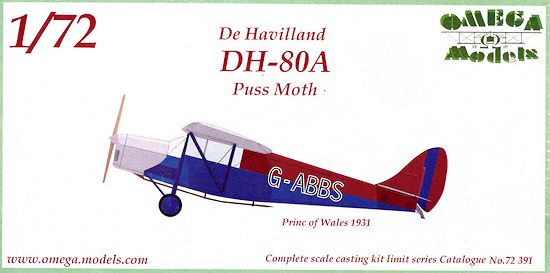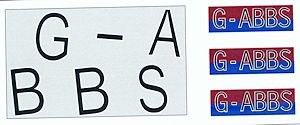
| KIT #: | 72-391 |
| PRICE: | $59.00 |
| DECALS: | One option |
| REVIEWER: | Peter Burstow |
| NOTES: | Resin with acetate for windows |

| HISTORY |
A substantially modified version of the single, unnamed D.H.80, the D.H.80A Puss
Moth was de Havilland's answer to customer demand for cabin comfort and an end
to the traditional flying clothes for themselves and their ladies.
| THE KIT |

The fuselage casting is in one piece, solid aft of the cockpit, with a separate
engine nacelle. No pesky fuselage joint to clean up. The cockpit parts include
the pilots seat and a bench for the two passengers. There is a control stick,
rudder bar and an instrument panel.
There are a large number of struts to make up the wing support, the
undercarriage and the cockpit roof framing. The instructions call for several
pieces of wire to be added to the framework but no measurements are given.
The piece of clear card is intended for the cabin windows, made up of numerous
small panels. The instructions suggest using Clearfix as an alternative. Either
way some careful masking will be needed.
A number of extra parts are present, some small bombs, alternate smaller wheels
and a pair of skis. These are to cater for some of the other boxings of the kit,
which differ only in decals and painting.
The instructions are a single A4 sheet, clearly printed in Czech and quaint
English, a colour profile and plan on one side, a short history, a parts layout
and an exploded diagram for showing construction on the other. There are two
prints of the same photo of the kit subject, and an additional photo detailing
the strut arrangement. It's needed, there is a complicated strut assembly
supporting the wings, and the construction diagram is less than clear and wrong
in detail. I anticipate a bit of trouble getting this all together. There is a
colour chart with references to generic
 names, AGAMA and Humbrol numbers, but no
reference apart from the profile as to what goes where.
names, AGAMA and Humbrol numbers, but no
reference apart from the profile as to what goes where.
The decals are for a single aircraft G-ABBS, in silver, red and blue, which was
in the Prince of Wales flying club. The registration letters for the sides of
the aircraft are printed with a blue and red background, nice enough, but it
means matching two colours or lots of trimming.
| CONCLUSIONS |
| REFERENCES |
A.J. Jackson, British Civil Aircraft 1919-1972: Volume II. Putnam, London, 1973.
February 2013
If you would like your product reviewed fairly and fairly quickly, please contact the editor or see other details in the Note to Contributors.